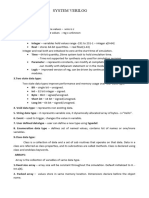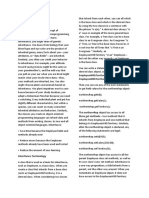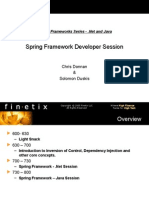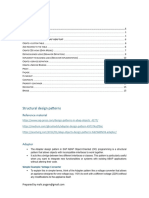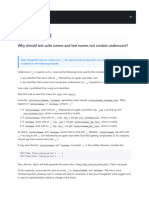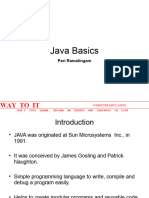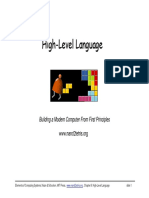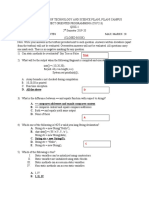SV Interview Question
Uploaded by
venkatasukumarreddychSV Interview Question
Uploaded by
venkatasukumarreddych1
System verilog
Basic Level
Questions
2
1. Difference between byte a and bit [7:0] a
Both bit and byte are 2-state data types and can store 8-bit or 1-byte data. The difference
between them is that ‘bit’ is unsigned whereas ‘byte’ is a signed integer.
2. What is the difference between bit and logic?
A bit is a 2-state data type having values as 0 or 1 whereas logic is 4 state data type
having values as 0, 1, x, z.
3. Why logic is introduced in SV? Or Why reg and wires are not sufficient?
4. Difference between reg and logic?
Both are 4 state variables. Reg can be only used in procedural assignments whereas
logic can be used in both procedural and continuous assignments
5. What are 2 state and 4 state variables? Provide some examples.
2 state data type can store two values 0 and 1 4 state data type can store two values 0, 1,
X, and Z
6. Difference between integer and int
Both can hold 32-bit signed integer values. The main difference between them is
integer – 4 state data type
int – 2 state data type
7. Difference between packed and unpacked arrays
Dynamic Array Queue
Memory needs to be allocated before using it For bounded queues, the size needs to be allocated.
i.e. array size is required to be allocated first. For unbounded queue can store unlimited entries.
Memory allocation may not be contiguous and
Memory allocation is contiguous. accessing intermediate variables needs to traverse
like a linked list traversal.
Queue [<size>] for bounded queue size.
new[ ] is used to create array memory.
Queue [$] for unbounded queue
3
Usually, head or tail elements are accessed. But
Similar to the fixed array, any array element can
queues also offer functionality to access any element
be accessed.
of the queue.
The size can be increased using a new [ ] For unbounded queues, the size of the queue expands
method to find out larger contiguous memory using push_back or push_front methods. The new
space and existing array elements get copied in data elements get added similar to linked list node
new space. addition.
8. Difference between dynamic and associative arrays
Dynamic Array Associative array
Need to allocate memory
Memory can be allocated when it is used
before using it.
Elements of an array can be of any type. We can store the
Elements of an array have
concatenation of various data types or class structures as
particular data types.
well.
9. Difference between dynamic array and queue
10. Difference between structure and union
Unions are similar to structures that can contain different data types members except
they share the same memory location. Hence, it is a memory-efficient data structure.
But it also restricts the user to use one member at a time.
11. How do you write a power b in sv code?
module arithmetic_op;
reg [1:0] a, b;
reg [3:0]out;
initial begin
a = 2'd3;
b = 2'd2;
out = a**b;
4
$display("a = %0d and b = %0d", a, b);
$display("pow: out = %0d", out);
end
endmodule
12. What are pass-by-value and pass-by-reference methods?
A pass-by-value argument passing mechanism does copy arguments locally and
operates on those variables. Any changes in variables in the function will not be visible
outside of the function.
function int fn_multiply(int a, b);
A pass-by-reference argument passing mechanism does not copy arguments locally but
reference to the original arguments is passed. This also means that any change in values
for the argument inside the subroutine will affect the original values of the variables,
function int fn_multiply(ref int a, b);
13. Why do we need randomization in SystemVerilog?
14. Difference between module and program block?
15. How do program block avoid the race condition?
16. Difference between === and == operators?
The output of “==” can be 1, 0, or X. The output would be ‘x’, if you compare two
variables if one or both the variables have one or more bits as X.
The output of “===” can only be 0 or 1. It is used to compare ‘x’ or ‘z’, whereas
ambiguous values can not be compared using the ‘==’ operator.
out = (A == B) and out = (A === B) results in tabular format.
A B Using == Using ===
0 0 1 1
1 1 1 1
0/1 x/z x 0
5
x x x 1
z z x 1
x z x 0
17. What are SystemVerilog interfaces and why are they introduced?
System Verilog provides an interface construct that simply contains a bundle of sets of
signals to communicate with design and testbench components.
Why are they introduced?
In Verilog for the addition of new signals, it has to be manually changed everywhere
that module has been instantiated. System Verilog made it easier to add new signals in
the interface block for existing connections.
Advantages:
1. It has increased re-usability across the projects.
2. A set of signals can be easily shared across the components bypassing its handle.
3. It provides directional information (mod ports) and timing information
(clocking blocks).
4. Interfaces can contain parameters, variables, functional coverage, assertions,
tasks, and functions.
5. Interfaces can contain procedural initial and always blocks and continuous
assign statements.
18. What is modport and clocking block?
Within an interface to declare port directions for signals modport is used
To specify synchronization scheme and timing requirements for an interface, a clocking
block is used.
19. Difference between initial and final block.
Initial Block Final Block
The initial block executes at the start of a final block executes at the end of the
simulation at zero time units. simulation without any delays
6
Usage: To display statistical information
Usage: Initial configuration set-up
about the simulation
20. What is cross-coverage?
21. Difference between code and functional coverage
Code coverage
Code coverage deals with covering design code metrics. It tells how many lines of code
have been exercised w.r.t. block, expression, FSM, signal toggling.
Functional coverage
Functional coverage deals with covering design functionality or feature metrics. It is a
user-defined metric that tells about how much design specification or functionality has
been exercised.
22. Different types of code coverage.
Code coverage deals with covering design code metrics. It tells how many lines of code
have been exercised w.r.t. block, expression, FSM, signal toggling.
The code coverage is further divided as
1. Block coverage – To check how many lines of code have been covered.
2. Expression coverage – To check whether all combinations of inputs have been
driven to cover expression completely.
3. FSM coverage – To check whether all state transitions are covered.
4. Toggle coverage – To check whether all bits in variables have changed their
states.
5.
23. Write rand constraint on a 3 bit variable with distribution 60% for 0 to 5 and 40% for
6,7. Write coverpoint for the same.
class rand_class;
rand bit [2:0] value;
constraint value_c {value dist {[0:5]:= 60, [6:7] := 40}; }
covergroup c_group;
cp1: coverpoint value {bins b1= {[0:5]};
7
bins b2 = {[6:7]};
}
endgroup
endclass
24. How many types of arrays are there? Explain
1. Fixed-size array in SystemVerilog: Array size is fixed throughout the simulation.
Its value will be initialized with a ‘0’ value.
The fixed size array can be further classified as a single-dimensional,
multidimensional array, packed, and unpacked array
2. Dynamic array in SystemVerilog: An array whose size can be changed during run
time simulation, is called dynamic array.
3. Associative array in SystemVerilog: An associate array is used where the size of a
collection is not known or data space is sparse.
8
Intermediate
level
questions
9
1. How to find indexes associated with associative array items?
An array manipulation method find_index can be used for the indices of an associative
array.
2. Difference between fork-join, fork-join_any, and fork-join_none
In fork-join, all processes start simultaneously and join will wait for all processes to be
completed.
In fork-join_any, all processes start simultaneously and join_any will wait for any one
process to be completed.
In fork-join_none, all processes start simultaneously and join_none will not wait for any
process to be completed.
So, we can say that fork-join and fork-join_any is blocked due to process execution time,
whereas fork-join_none is not blocked due to any process.
3. Difference Between always_comb and always@(*)?
always_comb always@(*)
always_comb is automatically triggered once at time always @ (*) will be triggered
zero but only after all procedural blocks (initial and for any change in the
always blocks) have been started. sensitivity list.
always @* is only sensitive to
always_comb is sensitive to changes within the
changes to the arguments of a
contents of a function.
function.
Time constructs or delays are
Time constructs or delays are not allowed
not allowed
4. Difference between structure and class
Structure Class
A structure can contain different Classes allow objects to create and delete
members of different data types. dynamically.
10
Does not supports inheritance,
Supports inheritance, polymorphism
polymorphism
Data members of structure are visible to Data members of class can be protected and
everyone will not be visible outside of class.
Supports data abstraction Supports only grouping of data.
5. Difference between static and automatic functions
1. By default, functions declared are static except they are declared inside a class
scope. If the function is declared within class scope, they behave as an automatic
function by default unless they are specifically mentioned as static functions.
2. All variables declared in a static function are static variables unless they are
specifically mentioned as an automatic variable.
3. All variables declared in an automatic function are automatic variables unless
they are specifically mentioned as a static variable.
6. Difference between new[ ] and new()
new[ ] – To create a memory. It can also be used to resize or copy a dynamic array.
Example:
int array [];
array = new[5]; // create an array of size = 5
array = new[8] (array); // Resizing of an array and copy old array content
Copy
new() – To create an object for the class, commonly known as ‘class constructor’.
class transaction;
// class properties and methods
endclass
transaction tr; // variable of class data_type transaction or class handle
tr = new(); // memory is allotted for a variable or object.
Copy
11
7. Difference between shallow and deep copy
Shallow Copy:
The shallow copy is used to copy
1. Class properties like integers, strings, instance handle, etc
2. Nested objects are not copied, only instance handles are copied which means
any changes are done in ‘nested copied object’ will also reflect in the ‘nested
original object’ or vice-versa.
Deep Copy:
The deep copy is the same as shallow copy except nested created objects are also copied
by writing a custom method. Unlike shallow copy, full or deep copy performs a
complete copy of an object.
8. How does the OOP concept add benefit in Verification?
Object Oriented Programming concept introduce concept of class and object in
SystemVerilog similar to other programming language like C++, Java, Python, etc that
provides following benefits
1. Inheritance: An Inheritance allows users to create an extended class from the
existing class. This promotes code reuse and can lead to more efficient
verification by having common functionality in the base class.
2. Polymorphism: Polymorphism means having many forms. A base class handle
can invoke methods of its child class which has the same name. Hence, an object
can take many forms.It uses virtual methods tha helps to override base class
attributes and methods.
3. Data Encapsulation and Hiding: Data encapsulation is a mechanism that
combines class properties and methods. Data hiding is a mechanism to hide
class members within the class. They are not accessible outside of class scope.
This avoids class member modification outside the class scope and its misuse. By
default, all class members are accessible with class handles in SystemVerilog. To
restrict access, access qualifiers are used.
4. Code Readability and Maintainability: The organized way of coding in OOPs
provides readable and maintainable code which allows verification engineers to
write tests and also build hierarchical verification testbench.
9. What is inheritance?
An Inheritance allows users to create an extended class from the existing class. The
existing class is commonly known as base class or parent class and the newly created
extended class is known as a derived class or child class or subclass. This promotes code
12
reuse and can lead to more efficient verification by having common functionality in the
base class.
10. What are the ‘super’ and ‘this’ keywords in SystemVerilog?
‘super’ keyword
The ‘super’ keyword is used in a child or derived class to refer to class members of its
immediate base class.
‘this’ keyword:
To refer to class properties or methods of the current class instance, this keyword is
used. In simple terms, this keyword is a handle of the current class object. It shall be
used only in non-static class methods. The ‘this’ keyword resolves the ambiguity of a
compiler when class properties and arguments passed to class methods are the same.
11. What is polymorphism and its advantages?
Polymorphism means having many forms. A base class handle can invoke methods of
its child class which has the same name. Hence, an object can take many forms.
Advantages
1. It makes code more reusable. The common functionality can be kept in the base
class and derived class-based functionality will be alone in its inherited or child
class. Thus it helps to write the code more modular.
2. Improves code readability and easy for code maintenance as common logic can
be placed in the base class itself.
3. Provides an encapsulation that allows objects to expose only required
functionality.
4. A new class can be added easily instead of modifying existing class functionality.
Thus it enablesflexibility.
12. What is a virtual function?
A virtual function or task from the base class can be overridden by a method of its child
class having the same signature (same method name and arguments).
In simple words, When a child class handle is assigned to its base class. On calling a
method using a base class handle, the base class method will be executed. On declaring
a method as a virtual method, a base class handle can call the method of its child class.
Usage:
1. Widely used in verification methodologies like UVM
2. Helps to reuse code
13
3. Helps to customize the behavior of verification components
13. What is the use of a scope resolution operator?
The scope resolution operator is used to
1. Access to static members (methods and class properties)
2. Class method declaration outside the class.
3. Importing a package and also accessing package items.
14. Difference between virtual and pure virtual function
Virtual function Pure virtual function
A virtual function from the base class can A pure virtual function is a method that
be overridden by a method of its child makes it mandatory for methods to be
class having the same signature (same implemented in derived classes whose
function name and arguments). prototypes have been specified in an
abstract class.
If a derived class doesn’t overwrite the pure
If there is no implementation in the virtual function, it will remain abstract and
derived class, the base class’s cannot be
implementation is executed.
instantiated.
Declared by using the keyword ‘virtual’ in Declared by using the keyword ‘pure
the base class. virtual’ in the base class.
15. What is a virtual interface and its need?
An interface represents signals that are used to connect design modules or testbench to
the DUT and is commonly known as a physical interface. The design and physical
interface are static in nature. Hence, they can not be used dynamically. In modern
testbench, randomized class objects are used and connect to the design dynamically.
Hence, to bridge the gap between the static world of modules and the dynamic world of
objects, a virtual interface is used as a pointer or handle for an actual interface.
14
16. What is a virtual class?
17. What are parameterized classes?
Parameterized classes are useful when the same class needs to be instantiated
differently. The default parameter can be set in the class definition. These parameters
can be overridden when it is instantiated.
18. What are rand and randc methods?
19. What are pre_randomize and post_randomize methods?
20. Explain bidirectional constraints
Bidirectional constraints are used to specify a relationship between two or more
variables or signals where one variable value has a dependency on other variables.
21. Is it possible to override existing constraints?
Yes, there are two ways to do so
22. Difference between :/ and := operators in randomization
Both are used to assign weightage to different values in the distribution constraints.
:/ Operator
1. For specific value: Assign mentioned weight to that value
2. For range of values ([<range1>: <range2>]): Assigns weight/(number of value) to
each value in that range
:= operator
For a specific value or range of value, the mentioned weight is assigned.
23. What is std::randomize?
It is one of the methods provided by SystemVerilog to randomize local variable without
declaring it as rand or randc. The inline constraint also can be written using the ‘with’
clause.
Example:
int value;
std::randomize(value) with {
value inside {5, 10, 15, 20};
};
Copy
15
24. Is it possible to call a function from constraint? If yes, explain with an
example.
Yes, a function can be called inside a constraint which can take input arguments and
also return a value.
25. Write a constraint - divisible by 5.
class constraint_example;
rand bit[3:0] val;
constraint value_c { val % 5 == 0; }
function void post_randomize();
$display("Randomized value = %0d", val);
endfunction
endclass
Copy
26. How to disable constraints?
27. How to disable randomization?
Yes, it can be disabled using rand_mode. To disable randomization, rand_mode(0) is
used. By default, randomization is enabled i.e. rand_mode(1)
Example: using rand_mode
28. Difference between static and dynamic casting
Casting is a process of converting from one data type into another data type for
compatibility.
Static Casting Dynamic Casting
static casting is only applicable Dynamic casting is used to cast the assigned values to
to fixed data types. the variables that might not be ordinarily valid.
It is a compile-time operation It is a run-time operation
16
It is a simple and efficient
It is more complex and less efficient than static casting
process
Compile failure will be seen
It can detect and handle errors during runtime.
for casting failure.
29. Difference between mailbox and queue
A queue is a variable size and ordered collection of elements whereas a mailbox is a
communication mechanism that is used to establish the connection between testbench
components. One component can put data into a mailbox that stores data internally
and can be retrieved by another component. The mailbox can be a parameterized
mailbox that can be put or get data of a particular data_type.
The queue has push_front/push_back/pop_front/ pop_back to operate over data
elements, whereas a mailbox has get/ put methods as commonly used methods to
exchange the data or objects.
30. What is semaphore and in what scenario is it used?
Semaphore is a built-in class in SystemVerilog used for synchronization which is a
container that contains a fixed number of keys. It is used to control the access to shared
resources.
Example: The same memory location is accessed by two different cores. To avoid
unexpected results when cores try to write or read from the same memory location, a
semaphore can be used.
31. What is input and output skew in clocking block?
To specify the synchronization scheme and timing requirements for an interface, a
clocking block is used.
Clocking Skew:
The input or output clocking block signals can be sampled before or after some time
unit delay known as clocking skew. It is declared as:
default input #2 output #3;
Where, Input clocking skew: #2 and Output clocking skew: #3
This means input signals is sampled #2 time unit before the clocking event and output
signals are driven after #3 time units after the clocking event.
32. What are the types of assertions?
17
Assertions are used to check design rules or specifications and generate warnings or
errors in case of assertion failures.
Types of assertions:
1. Immediate assertions – An assertion that checks a condition at the current
simulation time is called immediate assertions.
2. Concurrent assertions – An assertion that checks the sequence of events spread
over multiple clock cycles is called a concurrent assertion.
33. Difference between $strobe, $monitor and $display
System
Description
tasks
To display strings, variables, and expressions immediately in the active
$display
region.
To monitor signal values upon its changes and executes in the postpone
$monitor
region.
To display strings, variables, and expressions without appending the newline
$write
at the end of the message and executing in the active region.
To display strings, variables, and expressions at the end of the current time
$strobe
slot i.e. in the postpone region.
34. What is ignore bins?
35. Difference between ignore and illegal bins.
The ignore bins are used to specify a set of values or transitions that can be excluded
from coverage whereas the illegal bins are used to specify a set of values or transitions
that can be marked as illegal and a run-time error is reported for the same.
Example:
covergroup c_group;
cp1: coverpoint addr {ignore_bins b1 = {1, 10, 12};
ignore_bins b2 = {2=>3=>9};
}
18
cp2: coverpoint data {illegal_bins b3 = {1, 10, 12};
illegal_bins b4 = {2=>3=>9};
}
endgroup
Copy
36. How do you define callback?
37. What is DPI? Explain DPI export and import.
38. What is the implication operator in SVA? Explain its type?
39. What all bins are generated by the following code
coverpoint addr {bins b1 = {1, 10, 12};
bins b2[] = {[2:9], 11};
bins b3[4] = {0:8};
Copy
19
Difficult level
questions
20
1. What are the default values of variables in the SystemVerilog classes?
SystemVerilog class has a built-in new method which is commonly known as
constructor.
Default values for
2 state variables – 0
4 state variables – X
2. What are local and protected access qualifiers?
Local access qualifiers: If a class member is declared as a local, they will be available
to that class alone. The child classes will not have access to a local class member of their
parent class.
Protected access qualifiers: A protected class member can not be accessed outside
class scope except access by their child classes.
3. How do you implement the randc function in SystemVerilog?
4. Is it possible to generate random numbers without using rand or randc
keywords?
Yes, it is possible to generate random numbers using std::randomize() method provided
by SystemVerilog to randomize local variable without declaring it as a rand or randc.
The inline constraint also can be written using ‘with’ clause.
Example:
int value;
std::randomize(value) with {
value inside {5, 10, 15, 20};
};
Copy
21
5. Difference between @posedge and $rose?
@(posedge <signal>) is true when its value changes from 0 to 1.
$rose(<signal>) is evaluated to be true for value changes happening across two clocking
events from 0 or x or z to 1.
6. Talk about basic testbench components.
7. Explain the cycle of verification and its closure.
8. How will you test the functionality of interrupts using functional coverage?
The functionality of interrupt getting raised and being serviced by the testbench can be
verified by writing ‘Sequence of transitions’ coverpoint as follows
covergroup c_group;
cp1: coverpoint intr {bins b1 = (0 => 1 => 0);
}
endgroup
Copy
This allows testing interrupt is generated due to the stimulus and testbench is calling an
appropriate ISR to service the interrupt.
9. What is layered architecture in Verification?
Layered architecture involves structuring the verification environment into various
layers or levels that help to provide abstraction, scalability, reusability, etc.
Testbench Top and Test Layer: The testbench top is a top-level component that
includes interface and DUT instances. It connects the design with the test bench. The
reset, clock generation, and its connection with DUT is also done in testbench top.
The test is at the top of the hierarchy that initiates the environment component
construction and connection between them. It is also responsible for the testbench
configuration and stimulus generation process.
Based on the design feature verification, a directed or constrained random test is
written. The test case generates stimulus based on configurations or
Verification components Layer:
The Verification Components Layer serves as an abstraction that encapsulates the
behavior of the Design Under Test (DUT) while focusing on verifying the functionality
of the design using various verification components.
Coverage Layer: Coverage collection mechanisms track different aspects of the DUT
that have been exercised during simulation. This includes functional coverage, code
22
coverage, and assertion coverage, providing insights into the verification completeness
and identifying any areas that require additional testing.
Advantages of the layered approach:
1. Improved Verification Efficiency: Abstraction and modularity accelerate the
verification process.
2. Enhanced Reusability: Verification components can be reused across multiple
projects.
3. Better Test Coverage: A modular approach facilitates comprehensive testing.
4. Improved Maintainability: Focused components make verification code easier to
maintain and update.
10. How can you establish communication between monitor and scoreboard in
SystemVerilog?
The monitor observes pin-level activity on the connected interface at the input and
output of the design. This pin-level activity is converted into a transaction packet and
sent to the scoreboard for checking purposes.
The scoreboard receives the transaction packet from the monitor and compares it with
the reference model. The reference module is written based on design specification
understanding and design behavior.
Both are used to verify the correctness of the design in the verification environment
component. They are connected using a mailbox in a SystemVerilog-based verification
environment.
11. Difference between class-based testbench and module-based testbench.
class-based testbench module-based testbench
Testbench is developed around
Testbench is developed around individual design
multiple blocks of connected
modules.
design modules
The class-based stimulus is
generated and driven to the The physical interface is driven to the design
design.
23
Configuring a testbench needs modification in the
Provide more flexibility in terms
parameter used for the corresponding module that
of configuring testbench in
does not give the flexibility to change it during run
various modes as needed.
time.
Useful for complex design
Useful for smaller and simpler design verification.
verifications
12. How will be your approach if code coverage is 100% but functional coverage is
too low?
This can be possible when
1. Functional coverage bins (may be auto bins) generated for wide variable range
which is not supported by design.
2. Cross check if code coverage exclusions are valid so that it should not give false
interpretation of 100% code coverage.
3. Functional coverage implemented for feature (were planned during initial
project phasing), but those are not supported by the design now.
13. How will be your approach if functional coverage is 100% but code coverage is
too low?
This can be possible when
1. RTL code is not covered, so new stimulus or existing stimulus improvement is
required (assuming dead code is not a reason for low code coverage).
2. Another part is that 100% functional coverage suspects that covergroup for some
features might be missing. A detailed analysis is required to root cause of the
same. If the functional coverage is properly implemented, then code coverage
can be improved by new stimulus addition, and updating existing stimulus
which might include constraint-based testing.
14. Write an assertion for glitch detection.
realtime duration=50ns;
property glitch_detection;
realtime first_change;
24
@(signal) // Change in signal value (posedge and negedge)
(1, first_change = $realtime) |=> (($realtime - first_change) >= duration); // It saves
current time and also check the delay from previous edge
endproperty
ap_glitch_p: assert property(glitch_detection);
You might also like
- System Verilog: Question 1. What Is Callback ?100% (2)System Verilog: Question 1. What Is Callback ?15 pages
- To System Verilog (Data Types & Arrays)No ratings yetTo System Verilog (Data Types & Arrays)30 pages
- System Verilog Notes: Basics To AdvanceNo ratings yetSystem Verilog Notes: Basics To Advance37 pages
- Interview Questions For System Verilog: 1. What Is Clocking Block?100% (2)Interview Questions For System Verilog: 1. What Is Clocking Block?11 pages
- SystemVerilog Interview Questions PART-4No ratings yetSystemVerilog Interview Questions PART-417 pages
- 3.1 Structural Data Types: Wire and Reg: Integer I, y Real ANo ratings yet3.1 Structural Data Types: Wire and Reg: Integer I, y Real A3 pages
- Interview Questions in Verilog With AnswersNo ratings yetInterview Questions in Verilog With Answers14 pages
- Object Oriented Programming Lab Manual 1No ratings yetObject Oriented Programming Lab Manual 177 pages
- Abstract Classes and Interfaces Interview QuestionsNo ratings yetAbstract Classes and Interfaces Interview Questions5 pages
- C/C++ Programming Interview Questions and Answers: What Is Encapsulation??100% (1)C/C++ Programming Interview Questions and Answers: What Is Encapsulation??10 pages
- Object Oriented Systems Development Life Cycle100% (1)Object Oriented Systems Development Life Cycle51 pages
- Building Java Programs - A Back To Basics Approach 5th Edition Stuart Reges All Chapter Instant Download100% (3)Building Java Programs - A Back To Basics Approach 5th Edition Stuart Reges All Chapter Instant Download47 pages
- Presentation Java Basics 1530977673 47076No ratings yetPresentation Java Basics 1530977673 47076112 pages













